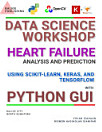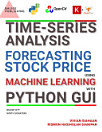DATA SCIENCE FOR RAIN CLASSIFICATION AND PREDICTION WITH PYTHON GUI
About this ebook
The dataset comprises 23 attributes, including: DATE: The date of observation.; LOCATION: The name of the weather station's location.; MINTEMP: The minimum temperature in degrees Celsius.; MAXTEMP: The maximum temperature in degrees Celsius.; RAINFALL: The amount of rainfall recorded for the day in mm.; EVAPORATION: Class A pan evaporation in mm for the 24 hours until 9 am.; SUNSHINE: The number of hours of bright sunshine in a day.; WINDGUSTDIR: The direction of the strongest wind gust in the 24 hours until midnight.; WINDGUSTSPEED: The speed of the strongest wind gust in km/h in the 24 hours until midnight.; WINDDIR9AM: The direction of the wind at 9 am.
The project utilizes several machine learning models, including K-Nearest Neighbor, Random Forest, Naive Bayes, Logistic Regression, Decision Tree, Support Vector Machine, Adaboost, LGBM classifier, Gradient Boosting, and XGB classifier. Three feature scaling techniques, namely raw scaling, MinMax scaling, and standard scaling, are employed. These machine learning models are utilized to analyze the weather attributes and make predictions about the occurrence of rainfall. Each model has its strengths and may perform differently based on the characteristics of the dataset.
Additionally, a GUI is developed using PyQt5 to visualize cross-validation scores, predicted values versus true values, confusion matrix, learning curves, decision boundaries, model performance, scalability, training loss, and training accuracy. These visualizations within the GUI provide a comprehensive understanding of the model's performance, learning behavior, decision-making boundaries, and the quality of its predictions. Users can leverage these insights to fine-tune the model and improve its accuracy and generalization capabilities. In addition, the GUI developed using PyQt5 also includes the capability to visualize features on a year-wise and month-wise basis. This functionality allows users to explore the variations and trends in different weather attributes across different years and months. With the year-wise and month-wise visualizations, users can gain insights into the temporal patterns and trends present in the weather data. It enables them to observe how specific attributes change over time and across different seasons, providing a deeper understanding of the weather patterns and their potential influence on rainfall occurrences.
Ratings and reviews
- Flag inappropriate
About the author
Vivian Siahaan is a fast-learner who likes to do new things. She was born, raised in Hinalang Bagasan, Balige, on the banks of Lake Toba, and completed high school education from SMAN 1 Balige. She started herself learning Java, Android, JavaScript, CSS, C ++, Python, R, Visual Basic, Visual C #, MATLAB, Mathematica, PHP, JSP, MySQL, SQL Server, Oracle, Access, and other programming languages. She studied programming from scratch, starting with the most basic syntax and logic, by building several simple and applicable GUI applications. Animation and games are fields of programming that are interests that she always wants to develop. Besides studying mathematical logic and programming, the author also has the pleasure of reading novels. Vivian Siahaan has written dozens of ebooks that have been published on Sparta Publisher: Data Structure with Java; Java Programming: Cookbook; C ++ Programming: Cookbook; C Programming For High Schools / Vocational Schools and Students; Java Programming for SMA / SMK; Java Tutorial: GUI, Graphics and Animation; Visual Basic Programming: From A to Z; Java Programming for Animation and Games; C # Programming for SMA / SMK and Students; MATLAB For Students and Researchers; Graphics in JavaScript: Quick Learning Series; JavaScript Image Processing Methods: From A to Z; Java GUI Case Study: AWT & Swing; Basic CSS and JavaScript; PHP / MySQL Programming: Cookbook; Visual Basic: Cookbook; C ++ Programming for High Schools / Vocational Schools and Students; Concepts and Practices of C ++; PHP / MySQL For Students; C # Programming: From A to Z; Visual Basic for SMA / SMK and Students; C # .NET and SQL Server for High School / Vocational School and Students. At the ANDI Yogyakarta publisher, Vivian Siahaan also wrote a number of books including: Python Programming Theory and Practice; Python GUI Programming; Python GUI and Database; Build From Zero School Database Management System In Python / MySQL; Database Management System in Python / MySQL; Python / MySQL For Management Systems of Criminal Track Record Database; Java / MySQL For Management Systems of Criminal Track Records Database; Database and Cryptography Using Java / MySQL; Build From Zero School Database Management System With Java / MySQL.
Rismon Hasiholan Sianipar was born in Pematang Siantar, in 1994. After graduating from SMAN 3 Pematang Siantar 3, the writer traveled to the city of Jogjakarta. In 1998 and 2001 the author completed his Bachelor of Engineering (S.T) and Master of Engineering (M.T) education in the Electrical Engineering of Gadjah Mada University, under the guidance of Prof. Dr. Adhi Soesanto and Prof. Dr. Thomas Sri Widodo, focusing on research on non-stationary signals by analyzing their energy using time-frequency maps. Because of its non-stationary nature, the distribution of signal energy becomes very dynamic on a time-frequency map. By mapping the distribution of energy in the time-frequency field using discrete wavelet transformations, one can design non-linear filters so that they can analyze the pattern of the data contained in it. In 2003, the author received a Monbukagakusho scholarship from the Japanese Government. In 2005 and 2008, he completed his Master of Engineering (M.Eng) and Doctor of Engineering (Dr.Eng) education at Yamaguchi University, under the guidance of Prof. Dr. Hidetoshi Miike. Both the master's thesis and his doctoral thesis, R.H. Sianipar combines SR-FHN (Stochastic Resonance Fitzhugh-Nagumo) filter strength with cryptosystem ECC (elliptic curve cryptography) 4096-bit both to suppress noise in digital images and digital video and maintain its authenticity. The results of this study have been documented in international scientific journals and officially patented in Japan. One of the patents was published in Japan with a registration number 2008-009549. He is active in collaborating with several universities and research institutions in Japan, particularly in the fields of cryptography, cryptanalysis and audio / image / video digital forensics. R.H. Sianipar also has experience in conducting code-breaking methods (cryptanalysis) on a number of intelligence data that are the object of research studies in Japan. R.H. Sianipar has a number of Japanese patents, and has written a number of national / international scientific articles, and dozens of national books. R.H. Sianipar has also participated in a number of workshops related to cryptography, cryptanalysis, digital watermarking, and digital forensics. In a number of workshops, R.H. Sianipar helps Prof. Hidetoshi Miike to create applications related to digital image / video processing, steganography, cryptography, watermarking, non-linear screening, intelligent descriptor-based computer vision, and others, which are used as training materials. Field of interest in the study of R.H. Sianipar is multimedia security, signal processing / digital image / video, cryptography, digital communication, digital forensics, and data compression / coding. Until now, R.H. Sianipar continues to develop applications related to analysis of signal, image, and digital video, both for research purposes and for commercial purposes based on the Python programming language, MATLAB, C ++, C, VB.NET, C # .NET, R, and Java.








